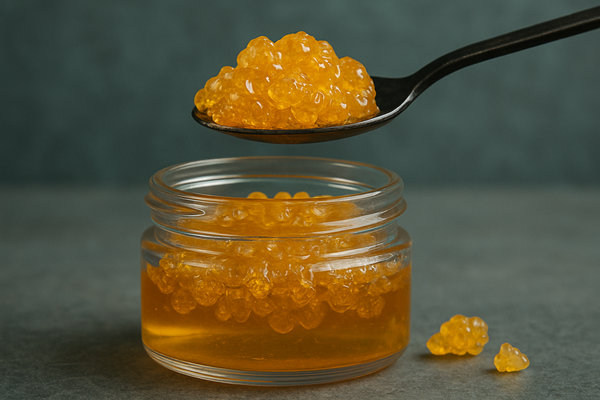The Key to THCA Diamonds: Mastering Supersaturation
May 26, 2025
If you’ve ever tried making THCA diamonds and found yourself puzzled by the word “supersaturation,” you’re not alone. It always pops up in SOPs and extraction forums, but rarely with a clear explanation. Thankfully, this week, we’re breaking it all down for you.

Supersaturation plays a big rosignificantin cannabis extraction, especially when you're working with crystallization techniques like diamond mining. From high-throughput labs to home setups with mason jars, grasping the principles behind supersaturation isn’t just theoretical; it’s the difference between inconsistent outcomes and dialed-in, repeatable results.
Let’s take a closer look at what it means, how to achieve it, and why extractors of all sizes rely on it.
What is Supersaturation in Hydrocarbon Extraction?
In the context of hydrocarbon extraction, supersaturation refers to a state where more THCA is dissolved into a solvent than it would normally be able to hold under standard conditions. It's all about pushing past the solubility limit, or the point at which a solvent can no longer dissolve additional solute, by carefully manipulating temperature, pressure, and agitation.

In systems using butane, propane, or blends of the two, THCA has a measurable solubility limit that varies depending on these conditions. Once that threshold is reached, any additional isolate added will usually remain undissolved. However, if conditions are dialed in correctly, you can temporarily dissolve more than that natural limit allows.
A saturated solution holds the maximum amount of solute that can be dissolved at a given temperature and pressure. A supersaturated solution, on the other hand, contains more solute than should theoretically stay dissolved under those same conditions.
The state of supersaturation is thermodynamically unstable, which is exactly what makes it useful. Supersaturation creates the ideal environment for crystal nucleation and growth, which is why it's the basis for evaporative crystallization in diamond production.
Temperature plays a major role. Heating increases solubility, giving you more headroom to load in THCA. Pressure can also help stabilize the system, especially in sealed vessels like diamond miners, keeping volatile solvents in a liquid state long enough to fully saturate the mix.
Supersaturation as the Foundation for Crystallization
Supersaturation is the critical setup phase for anyone using hydrocarbon solvents to grow THCA diamonds. In diamond mining, the goal is to create a solution that holds more THCA than it should be able to under normal conditions.

Once the system reaches this supersaturated state, the solution becomes primed for nucleation, which is the initial stage of crystal formation. Without that excess load of dissolved THCA, there is simply not enough material in the solution to drive meaningful crystallization.
Evaporative crystallization relies entirely on supersaturation. As the solvent is slowly removed, either through passive evaporation or controlled pressure release, the concentration of THCA in the remaining liquid increases until crystals begin to form.
Once all of the crystallization conditions are carefully controlled, the process is relatively predictable, allowing extractors to tune for specific outcomes like crystal size and shape.
On the other hand, cold crashing depends more on temperature swings to reduce solubility and force crystallization. While effective in some workflows, it does not require a supersaturated starting point and is generally considered less efficient or reliable for large-scale or high-purity diamond production.
The liquid left after saturation, often referred to as the mother liquor, plays a key role throughout. It is not only the medium where crystallization happens initially. Still, it can also be reused in recrystallization steps to refine product purity, maximize yield, and optimize solvent usage across multiple cycles.
The Supersaturation Process Step-by-Step
Achieving a supersaturated solution of THCA in hydrocarbons isn’t complicated, but it requires some intention and careful control.

It doesn't matter if you're working with basic glassware or a purpose-built diamond miner; the skill lies in understanding solvent dynamics well enough to operate at the edge of efficiency without stepping into dangerous or quality-compromising territory.
-
Step 1: Choose your container: Diamond miners are preferred for a reason. They’re built to handle pressure, maintain a sealed environment, and often allow for controlled venting. That said, mason jars still see plenty of use in smaller setups because they’re easy to open, load, and reseal. The downside is they can’t be pressurized and aren’t suited for volatile environments, so your control over conditions is limited.
-
Step 2: Add your solvent and isolate: Start with the volume of solvent you plan to use, then begin introducing THCA isolate. If you’ve dialed in your process, you may already have a good estimate of your solubility limit. Knowing how much your solvent can hold before saturation helps minimize waste and keeps things efficient.
-
Step 3: Apply heat and agitation: Warming the solution to around 80 to 100 degrees Fahrenheit helps increase solubility. Agitation is key here. It keeps the mixture moving, breaks up isolate clumps, and allows the solvent to interact more evenly with the THCA.
-
Step 4: Add more isolate incrementally: Continue introducing isolate until it stops dissolving. You’ll notice that the solution turns clear at first, then stays cloudy or leaves solids behind once you’ve reached the limit.
-
Step 5: Hold at temperature: Let the solution stabilize for a few hours at your target temperature to maintain uniformity.
Whenever you’re working with hydrocarbons, always prioritize closed systems and proper safety protocols. Using vacuum or inert gas environments helps prevent oxidation and limits solvent loss during heating and agitation.
Make sure to avoid open-air processing, especially when heating, since the risk of ignition increases significantly when working with volatile solvents.
Indicators You’ve Reached Supersaturation
Knowing when your system has reached supersaturation is mostly about watching how the solution behaves under controlled conditions.
The clearest indicator is the presence of undissolved THCA that settles at the bottom of the vessel, even after you've applied heat and continued agitation. If you’ve maintained the proper temperature and the isolate still refuses to go into solution, you’ve likely maxed out the solvent’s capacity.
You might also notice a clear transparent layer with some suspended particles or light cloudiness, especially as the system cools. It’s often a sign that the solution is right on the edge of saturation, and minor changes in temperature or pressure could tip it into nucleation.
Keeping detailed lab records is essential here. Once you identify the solvent-to-isolate ratio that consistently gets you to supersaturation under specific conditions, you can repeat it with much less guesswork.
Some labs use simple gravimetric checks by weighing isolate before and after dissolution to confirm how much has actually gone into the solution, which helps tighten formulations and improves yield forecasting. With good tracking and visual observation, hitting supersaturation becomes a predictable and repeatable part of the crystallization workflow.
Common Pitfalls and How to Avoid Them
Even a well-understood process like supersaturation can go sideways if key variables aren’t controlled.
One of the most common mistakes is overheating the solution. While mild heat improves solubility, pushing temperatures too high can degrade cannabinoids, oxidize terpenes, and destabilize the overall mix.
Another issue is adding isolate too quickly. Dumping in large amounts all at once can lead to clumping, uneven dissolution, or clogging at the bottom of the vessel, especially without sufficient agitation.
Under-agitation is another frequent culprit. If the solution isn’t moving enough, saturation happens unevenly, which slows down the process and affects the uniformity of your mother liquor.
Pre-filtration is often overlooked but makes a noticeable difference. Skipping this step can leave behind lipids, pigments, or other impurities that interfere with crystal nucleation and reduce yield or clarity.
The use of proper equipment, consistent process control, high-purity solvents, and clean workspaces all contribute to a more efficient and reliable crystallization setup. On the compliance side, keep in mind that any time hydrocarbons are heated, you’re operating under stricter safety scrutiny.
Regulatory agencies expect extractors to have clear documentation of their safe handling practices and control of residual solvent levels in the final product, especially in regulated markets.
Ready to Elevate Your Crystallization Workflow?
Supersaturation is more than just a technical step in diamond production. It’s the foundation for consistent, high-yield THCA crystallization. Solubility dynamics might start the reaction, but the cumulative effect of your heat profile, agitation method, and filtration strategy determines whether your final product hits the mark or falls short.
From boutique labs to industrial operations, refining your control over supersaturation is a clear sign of process maturity. It leads directly to better transparency, cleaner products, and results that you can trust every time—and it all starts with clean input.
If you’re looking to push your process further and want filtration media that meets your strict standards, Media Bros has your back. Our team is here to help you find the right solution that’s tailored to your system and ultimate extraction goals.
To learn more about how our expertise and products can best support your extraction workflow, reach out to sales@mediabros.store or call us at 1-503-308-7138. We’ll help you get set up with the tools that let your process and your product shine.






